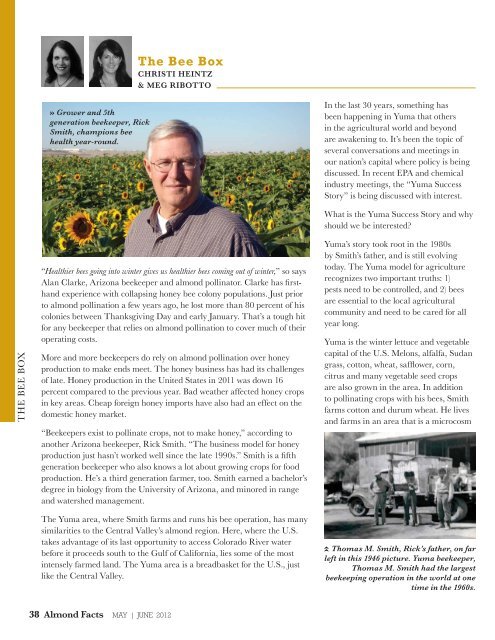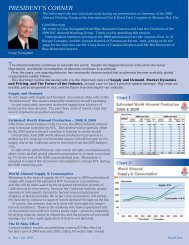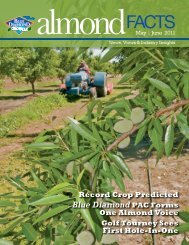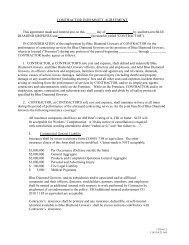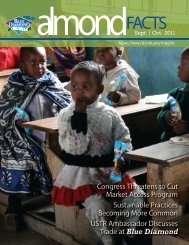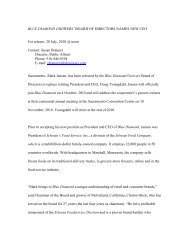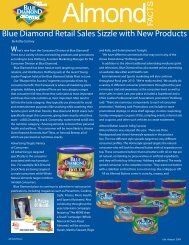View the PDF (24mb) - Blue Diamond Growers
View the PDF (24mb) - Blue Diamond Growers
View the PDF (24mb) - Blue Diamond Growers
Create successful ePaper yourself
Turn your PDF publications into a flip-book with our unique Google optimized e-Paper software.
The Bee Box<br />
CHRISTI HEINTZ<br />
& MEG RIBOTTO<br />
» Grower and 5th<br />
generation beekeeper, Rick<br />
Smith, champions bee<br />
health year-round.<br />
In <strong>the</strong> last 30 years, something has<br />
been happening in Yuma that o<strong>the</strong>rs<br />
in <strong>the</strong> agricultural world and beyond<br />
are awakening to. It’s been <strong>the</strong> topic of<br />
several conversations and meetings in<br />
our nation’s capital where policy is being<br />
discussed. In recent EPA and chemical<br />
industry meetings, <strong>the</strong> “Yuma Success<br />
Story” is being discussed with interest.<br />
What is <strong>the</strong> Yuma Success Story and why<br />
should we be interested?<br />
THE BEE BOX<br />
“Healthier bees going into winter gives us healthier bees coming out of winter,” so says<br />
Alan Clarke, Arizona beekeeper and almond pollinator. Clarke has firsthand<br />
experience with collapsing honey bee colony populations. Just prior<br />
to almond pollination a few years ago, he lost more than 80 percent of his<br />
colonies between Thanksgiving Day and early January. That’s a tough hit<br />
for any beekeeper that relies on almond pollination to cover much of <strong>the</strong>ir<br />
operating costs.<br />
More and more beekeepers do rely on almond pollination over honey<br />
production to make ends meet. The honey business has had its challenges<br />
of late. Honey production in <strong>the</strong> United States in 2011 was down 16<br />
percent compared to <strong>the</strong> previous year. Bad wea<strong>the</strong>r affected honey crops<br />
in key areas. Cheap foreign honey imports have also had an effect on <strong>the</strong><br />
domestic honey market.<br />
“Beekeepers exist to pollinate crops, not to make honey,” according to<br />
ano<strong>the</strong>r Arizona beekeeper, Rick Smith. “The business model for honey<br />
production just hasn’t worked well since <strong>the</strong> late 1990s.” Smith is a fifth<br />
generation beekeeper who also knows a lot about growing crops for food<br />
production. He’s a third generation farmer, too. Smith earned a bachelor’s<br />
degree in biology from <strong>the</strong> University of Arizona, and minored in range<br />
and watershed management.<br />
Yuma’s story took root in <strong>the</strong> 1980s<br />
by Smith’s fa<strong>the</strong>r, and is still evolving<br />
today. The Yuma model for agriculture<br />
recognizes two important truths: 1)<br />
pests need to be controlled, and 2) bees<br />
are essential to <strong>the</strong> local agricultural<br />
community and need to be cared for all<br />
year long.<br />
Yuma is <strong>the</strong> winter lettuce and vegetable<br />
capital of <strong>the</strong> U.S. Melons, alfalfa, Sudan<br />
grass, cotton, wheat, safflower, corn,<br />
citrus and many vegetable seed crops<br />
are also grown in <strong>the</strong> area. In addition<br />
to pollinating crops with his bees, Smith<br />
farms cotton and durum wheat. He lives<br />
and farms in an area that is a microcosm<br />
The Yuma area, where Smith farms and runs his bee operation, has many<br />
similarities to <strong>the</strong> Central Valley’s almond region. Here, where <strong>the</strong> U.S.<br />
takes advantage of its last opportunity to access Colorado River water<br />
before it proceeds south to <strong>the</strong> Gulf of California, lies some of <strong>the</strong> most<br />
intensely farmed land. The Yuma area is a breadbasket for <strong>the</strong> U.S., just<br />
like <strong>the</strong> Central Valley.<br />
Thomas M. Smith, Rick’s fa<strong>the</strong>r, on far<br />
left in this 1946 picture. Yuma beekeeper,<br />
Thomas M. Smith had <strong>the</strong> largest<br />
beekeeping operation in <strong>the</strong> world at one<br />
time in <strong>the</strong> 1960s.<br />
38 Almond Facts MAY | JUNE 2012


